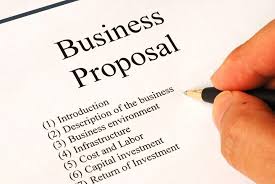Are you struggling to write a business proposal that will impress your potential clients and win you the contract? Look no further! In this blog, we will share with you the ultimate guide on how to write a business proposal that stands out from the competition. Whether you’re a seasoned entrepreneur or just starting your business journey, our tips and tricks will help you craft a persuasive and professional proposal that gets results. So, grab a pen and paper and get ready to take your proposal writing skills to the next level.
What Is a Business Proposal?
Attention business owners! If you’re looking to win new clients and secure projects, a compelling business proposal is a must-have. This document is a powerful tool that showcases your services, justifies your qualifications, and persuades potential clients to choose your business.
But wait, don’t confuse it with a business plan! While a business plan defines an organization’s objectives and strategies, a business proposal is a tailored pitch that demonstrates how your business can meet the specific needs of another business. In this article, we’ll dive deeper into the art of crafting a winning business proposal that effectively markets and sells your products or services.
What Are the Types of Business Proposals?
There are three major types of business proposals:
Type |
Function |
| Formally Solicited Proposals | When you reply to a formal request for a business proposal, it is considered to be a formally solicited business proposal. In this case, you are aware of every criterion and have a large amount of information about a potential buyer, if not all of it. |
| Informally Solicited Proposals | When a formal request for a proposal is not there, informally solicited business proposals are made. A potential buyer is attracted by your offerings and requests a proposal so they can assess it. An informal request for proposals necessitates much more investigation on your part. |
| Unsolicited Proposals | Unsolicited business proposals usually adopt a universal, one-size-fits-all strategy. They don’t take the customer or their needs into account. |
How to Write a Business Proposal?
While the format of business proposals might vary, all business proposals should contain a few essential components. Here is a step-by-step guide on how to write a business proposal:
1. Create Your Title Page
Since this is the first element your client will be seeing, it’s essential to express your brand and concept in a way that is brief but detailed. Consider it to be visual content that must deliver a lot of information rapidly because viewers will only look at it briefly.
A potential client can get a sense of the marketing plan and what will come next in the proposal by creating a great, solid title page.
Basic information like your business name and contact details, your business logo, your client’s name and contact details, the date, and a title are all included on this page.
2. Compile a Table of Contents
Every successful business proposal template must include a table of contents. So, the next step in how to write a business proposal is to add a table of contents. It makes your proposal scannable and simple to read.
By including a table of contents, you make it simple for the executives who are reading your proposal to browse it at their own pace. Additionally, they can quickly read the sections of the proposal that stand out to them.
Your contents page should be arranged in chronological order. Avoid making your list overly specific because it will come across as crowded and overbearing. There are many different kinds of proposals, including marketing and sales proposals, and the table of contents can inform your client of what you’re offering and how it will benefit them.
3. Write a Cover Letter
No powerful guide on how to write a business proposal would be complete without a cover letter. The purpose of your cover letter is to introduce yourself. In certain proposals, the cover letter may even come first, before the table of contents, as a method to introduce the idea.
Your cover letter shouldn’t be longer than one page and should be brief. Describe your company’s history, mission of the company, and distinctive selling point in a few lines. Leave your contact details and invite your readers to get in touch with you if they have any queries.
4. Write the Executive Summary
It gives a brief overview of everything in your paper. In other words, create a business proposal framework that is simple to read and emphasizes your value proposition. The executive summary explains in significant detail why the proposal is being sent and why your proposal is the ideal one for the potential client. Specificity is important in this case.
Introduce your business, describe your company’s goals and objectives in general, highlight any accomplishments so far, outline your future course of action, and illustrate how the plan you’re creating serves as the first step on that course.
5. Outline Your Customers’ Problems and Your Company’s Solutions
Solving a buyer’s problem is the goal of developing a business proposal. The problem statement should be outlined as precisely as feasible. This makes your client feel a feeling of urgency. They’ll be looking for a fix for the issue. And you already have that answer.
Your proposal must identify the client’s issue and then promptly offer a potential solution. A satisfied client who is looking forward to working with you is the result of the problem statement and the solution.
6. Create a Pricing Table
An essential component of any business proposal is a budget or pricing section; therefore, before getting into the details of any proposal writing, you should plan your pricing strategy.
Your pricing structure should be laid out in an easy-to-read table. Offer alternatives for recurring payments on a monthly and yearly basis. Offer reduced prices in exchange for long-term commitments. Provide alternatives, improvements, and add-ons. Transparency is essential in this part. Make sure your customers can easily comprehend what they’re paying for and how to customize your service.
7. Share More Information About Your Company
The background of your company should be told on the “about us” page of your business proposal, with yourself, the owner, acting as the major lead character. A decent about us section should be concise but still have all the components, such as:
- A brief description of your business and the project’s background.
- Introducing your customers to the person they will be collaborating with on the project by providing a quick bio of each member of your team.
- Describe how you plan to keep achieving your goals.
- How did you and your group approach locating a solution for your issue?
- Describe the problem that your company intended to solve.
8. Summarize Your Qualifications
Explain why you’re the ideal candidate for the opportunity in this part of your business proposal document. Incorporate customer success stories into your case studies, and make sure to highlight any relevant achievements or certifications that will increase your credibility. You can highlight any relevant degrees, training related to your industry, certificates, previous accomplishments in projects of the same sort, years of experience, etc.
Throughout this process, you must illustrate your knowledge through qualifications. Showcase it if your business or organization has a history of successfully resolving this particular problem and is certified.
9. Lay Out the Terms of the Agreement
The last step in how to write a business proposal is to lay out the terms of the agreement. Your marketing proposal should conclude with a summary of the terms and conditions that will help your clients understand the offer you are presenting to them. It’s crucial to speak with a legal representative while drafting this part because proposals might be regarded as imposed by law contracts in some jurisdictions.
Include a place where the client can sign and date the proposal, accepting the terms you’ve offered if you prepared a unique proposal that you anticipate your client would accept. If it wasn’t covered in the conclusion, give the client a quick rundown of the project, including the general timeline, payment schedule, and terms, so they know what they’re signing off on.
After Sending: Tips on How to Follow Up
One can easily become overwhelmed when waiting to hear back from a client after presenting a business proposal, but always remember to be patient. Here are some tips on how to follow up:
- Give them time: Before sending a follow-up, wait at least a week. If they’ve acknowledged receipt of your proposal, allow them one week from the date of acceptance.
- Grab their attention with a good subject line: They are more likely to open your email if the subject line is interesting.
- Be brief: Make it clear in your follow-up that you are available for any queries and make it simple for them to contact you again.
- Avoid high-pressure, sales language: Your objective here is to secure a client, not a customer.
- Be friendly, approachable, and authentic: Act as though you are seeking out to your favorite coworker by being kind yet informal.
- Know when to quit: It’s time to move on if your client hasn’t reacted to the three follow-ups.
Business Proposal Ideas
A business proposal can sound like a big thing; here are a few ideas to make business proposal writing easy for you:
1. Start With an Outline
Outline the main components of your business proposal and the important details you want to include before you start writing. By doing this, you can write with greater clarity and maintain the integrity of your content.
2. Include Data and Visuals
Include concrete, quantitative data that highlights the value of your company to help draw the prospect’s attention as well as differentiate you from the competition. It is also helpful to include graphics such as charts and graphs to strengthen your proposal.
3. Add Social Proof
Including social proof increases the credibility of your proposition. Clients are more likely to trust their peers and some customers than business owners. It might therefore be very beneficial to include things like client quotes and testimonials.
4. Incorporate Video Into Your Proposal
Multimedia components can be used to improve the proposal experience. They can add depth and interest to your document.
5. Use a Call-To-Action
After reading your proposal, you must ensure the reader understands what to do next. The best method to get there is with a clear call to action. Specify and emphasize what they should do in order to capitalize on the curiosity your proposal has created. Without such direction, you possibly leave the reader hanging.
6. Include Up-Sell and Add-on Opportunities
Include some further details about your company for the reader to act on if you want to make the most of their interest in your business proposal. They must be aware of your further offerings.
7. Create a Sense of Urgency
People usually delay and take their time when making decisions when there is no sense of urgency. After reading your company proposal, potential customers should feel that this is the ideal opportunity to sign up for your services. Declaring your short- and long-term objectives for their business is one way to do this.
8. Keep It Simple
Avoid using too much business language and keep your words short and straightforward. Your proposal should be clear enough that anyone who picks it up will understand it.
9. Make the Decision for Them
You should exceed their expectations with your offer and take every step possible to avoid conflict and disagreements along the road.
10. Stay On Brand
Keep your brand consistent and demonstrate to the client what makes you stand out from the competition.
11. Quality Control
Your proposal must be organized and complete. You don’t want to come out as careless and unprofessional, which would undermine your messaging.
Conclusion
Marketing your services to potential customers is a necessary element of operating and managing your business, and as you do it often, it will only get simpler. There is no denying how much effort it takes to learn how to prepare a business proposal. Learn how to tackle complex business problems using in-demand tools with our PCP Business Analysis Program. Make the most of this business analysis course with Masterclasses from IBM, and Purdue University. Enroll Today!



